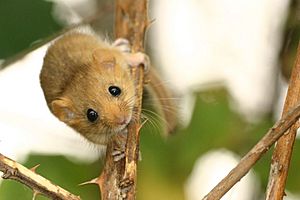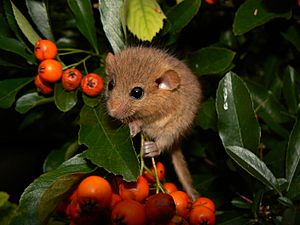Hazel dormouse facts for kids
Quick facts for kids Hazel dormouseTemporal range:
Middle Miocene – Recent |
|
|---|---|
 |
|
| Conservation status | |
| Scientific classification | |
| Kingdom: | |
| Class: | |
| Order: | |
| Family: | |
| Subfamily: | |
| Genus: |
Muscardinus
|
| Binomial name | |
| Muscardinus avellanarius (Linnaeus, 1758)
|
|
The hazel dormouse (Muscardinus avellanarius) is a tiny, cute rodent that lives in forests. It's also called the common dormouse. This little creature is the only living species in its group, called a genus.
Hazel dormice are quite small. They are about 6 to 9 centimeters (2.4 to 3.5 inches) long, not including their tail. Their tail adds another 5.7 to 7.5 centimeters (2.2 to 3 inches). They usually weigh between 17 and 20 grams (0.6 to 0.7 ounces). But before they go into hibernation for the winter, they can get much heavier, up to 30 to 40 grams (1 to 1.4 ounces)!
These dormice sleep through the winter, from October until April or May. In the UK, people often just call them "dormice." Hazel dormice are originally from northern Europe and Asia Minor. They are the only type of dormouse that naturally lives in the British Isles. Another type, the edible dormouse, was brought there by accident and now lives there too.
Contents
Protecting the Hazel Dormouse
The hazel dormouse is a special animal that needs protection. It is listed as a European Protected Species. This means it has legal protection in the UK under the Wildlife and Countryside Act. These laws help keep dormice safe and protect their homes.
All About the Hazel Dormouse
The hazel dormouse is the only small mammal in Britain that has a completely furry tail. It has soft, golden-brown fur and big, dark eyes. Dormice are nocturnal, which means they are most active at night. They spend most of their time awake looking for food in trees. They prefer to travel along tree branches instead of going down to the ground. This helps them stay safe from dangers.
Hibernation and Torpor
When winter arrives, usually in early October, hazel dormice go into hibernation. They build cozy nests under fallen leaves on the forest floor. They stay asleep until spring, around late April or early May.
When they wake up, they build new nests. These nests are made from things like honeysuckle bark, fresh leaves, and grasses. If the weather is cold and wet, and there isn't much food, a dormouse might go into a mini-sleep called torpor. This is like a temporary hibernation that helps them save energy. They curl up into a ball and go to sleep. Dormice spend a lot of their lives sleeping, either hibernating in winter or going into torpor in summer!
How to Spot Dormouse Signs
You might not see a dormouse, but you can often find signs they've been around! One common sign is a hazelnut with a neat, round hole in its shell. This shows that a small rodent like a dormouse, wood mouse, or bank vole opened it. Other animals, like squirrels or jays, usually split the nut completely or make a jagged hole.
If you look very closely at the hole in a hazelnut, you can tell who made it.
- A dormouse leaves tooth marks that are at an angle to the hole's inner rim.
- A wood mouse leaves tooth marks that are parallel to the hole, with rough marks on the nut's surface.
- A bank vole leaves parallel grooves, but no rough marks.
What Dormice Eat
Hazel dormice eat many different foods they find in trees and bushes. Their diet changes throughout the year:
- They enjoy nectar and pollen from flowers.
- They eat berries and nuts.
- Insects are a favorite, especially aphids and caterpillars.
- They also munch on the buds of young leaves.
- Hazel nuts are super important! Dormice eat a lot of them to get fat before hibernation. Hazel trees also provide many insects for them to eat.
- If there aren't many hazel trees, they might eat fruit from Hornbeam and blackthorn trees.
Dormice need different food sources at different times of the year to stay healthy and survive.
Where Dormice Live
Hazel dormice like to live in certain places:
- Woodlands: Forests are their main home.
- Hedgerows: These are like natural fences made of many different plants. The best hedgerows are tall (about 3 to 4 meters or 10 to 13 feet) and haven't been cut for at least seven years. This is because many shrubs need this long to grow fruit.
- They sometimes use special nestboxes that people put out for them.
- Dormice usually don't travel far from their nests, often less than 70 meters (230 feet).
Important Trees and Shrubs for Dormice
Certain trees and shrubs are very important for dormice:
- Hazel: This is their main food source. Hazel trees have many branches, which makes it easy for dormice to move around. The dormouse's Latin name, avellanarius, actually means "hazel."
- Oak: Dormice eat oak flowers and the insects that live on the tree. They don't often eat acorns.
- Honeysuckle: They eat the flowers and fruit. Dormice also use the bark to build their nests.
- Bramble: Dormice eat the flowers and fruits. The thorns on brambles help protect their nests.
- Sycamore: They eat the pollen from sycamore trees and the insects found there.
- Ash: Dormice eat the seeds of ash trees while they are still on the tree.
- Viburnum lantana: They eat the fruits and flowers.
- Yew: Dormice eat the fruits.
- Hornbeam: They eat the seeds.
- Broom: Dormice eat the flowers in early summer.
- Sallow: They eat unripe seeds and the insects that live on this plant.
- Birch: Dormice eat the seeds.
- Sweet chestnut: They eat the flowers and the chestnuts.
- Blackthorn: Dormice eat the fruit.
- Hawthorn: They eat the flowers in the spring and sometimes the fruit.
Threats to Dormice
Dormice face several dangers:
- Predators: Animals like Badgers, foxes, stoats, and weasels hunt dormice. Since dormice are nocturnal, owls are also a threat.
- Lack of food: If hedges are trimmed too often, or if other animals (like squirrels) eat all the food, dormice can struggle to find enough to eat.
- Habitat loss: When forests and hedgerow habitats are destroyed, dormice lose their homes and food sources.
Images for kids
See also
 In Spanish: Lirón enano para niños
In Spanish: Lirón enano para niños






